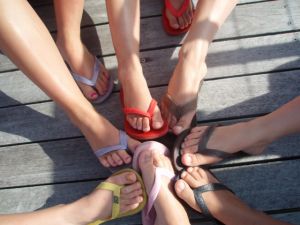The Effects of Flip Flops on Your Feet and Body

We’ve heard a lot about the damaging effects of high heels on your body – but are flip flops any better? It’s so easy to slip into flip flops – but how and when should we wear them? Chief Podiatrist Michelle Champlin explains the effects of flip flops on your feet and body.
Michelle Champlin leads the foot experts at Dubai Podiatry Centre and has been practicing as a podiatrist in Dubai for over 15 years. She has seen plenty of foot injuries and accidents related to flip flops over the years, as well as longer term chronic foot complaints that over use of flip flops have contributed to. It’s not all bad news – there is a time and a place for flip flops as well as styles of flip flops that improve wearability.
What kinds of problems can wearing flip flops cause?
Any shoe that is secured to your foot with straps, buckles or laces is preferable to a slip on style – whether ballet pumps or flip flops. The risk of ankle sprains/twists is higher with slip on styles. They also encourage you to ‘over-pronate’ – when your foot and ankle ‘rolls in’ as your foot works to keep the flip flop on. You most likely won’t be aware of this compensation while you walk.
Increased strain on the plantar fascia tendon, leading to a burning or stabbing sensation in your heel when you walk – plantar fasciitis. This is due to the lack of arch support in the flip flop – encouraging your medial long arch to collapse and too much strain on the plantar fascia that connects your forefoot to your heel bone. The lack of support can also contribute to splaying of your forefoot – collapsed transverse arch and formation of bunions and bunionettes and sometimes metatarsalgia.
Toes tend to claw or ‘scrunch up’ when your foot is mid-air to keep the flip flop on – again you won’t be aware your foot is doing this.
Friction from the flip flop thong can cause blisters or minute cuts between your toes, leading to entry points for fungal or bacterial infections such as athlete’s foot.
When wearing flip flops, you take shorter strides and roll your ankle inwards – leading to ankle, knee or hip pain as more weight is placed on the medial, or inside, of your foot and knee joints. Wearing thin soled, unsupportive flip flops for long periods of walking, such as when sight seeing, can lead to stress fractures of your metatarsals. “These ‘marching foot’ fractures used to be seen mainly in soldiers, but we are seeing more and more of these overuse injuries in people wearing flip flops for long periods of walking on hard surfaces,” explains Mrs Champlin.
Callous builds up much quicker, especially on your heels, when wearing open shoes such as sandals or flip flops, due to the exposure to the drying, moisture wicking atmosphere. Wearing socks within closed shoes also helps remove dead skin, which is why you may have noticed you’ve developed more hard skin when moving to Dubai from a colder climate such as in Europe, for example.
Tips for Choosing & Wearing Flop Flops
• Choose flip flops with thicker soles for better shock absorption. Flip flops (or any shoe) that fold in half will not provide much cushioning.
• Look for thick leather thongs on the flip flop that are less likely to chafe.
• Mrs Champlin recommends that you DO wear flip flops in areas where you are more prone to pick up viral (verrucas) or fungal (athlete’s foot) infections – moist or dark places such as changing rooms, poolside or on the dive boat.
• Limit flip flop wearing to shorter periods – such as to and from the beach. Avoid wearing them for longer periods of walking, such as around the mall.
• Never wear flip flops whilst running or playing sports – they provide no protection and raise the risk of sprain and injury.
• Replace your flip flops when you notice wear / tear or reduced cushioning. Normally every 3-4 months.
• Don’t forget sunscreen for your exposed feet! Mrs Champlin sees incidences of skin cancer on exposed areas of skin on the feet, an often forgotten area when applying sun screen and especially crucial in sunny climates such as the UAE.
If you are worried that you may have picked up a verruca, fungal infection, or are experiencing any kind of pain in your feet, contact the foot experts at Dubai Podiatry Centre on +971 4 3435390 for fast, friendly and expert help.







